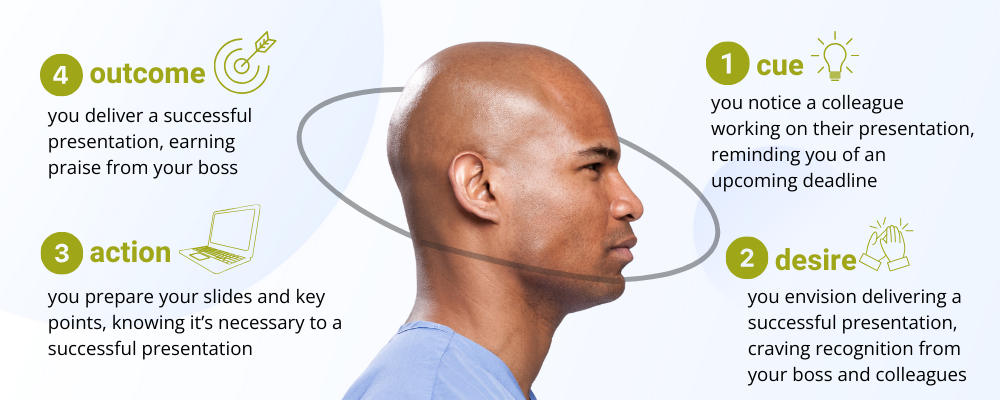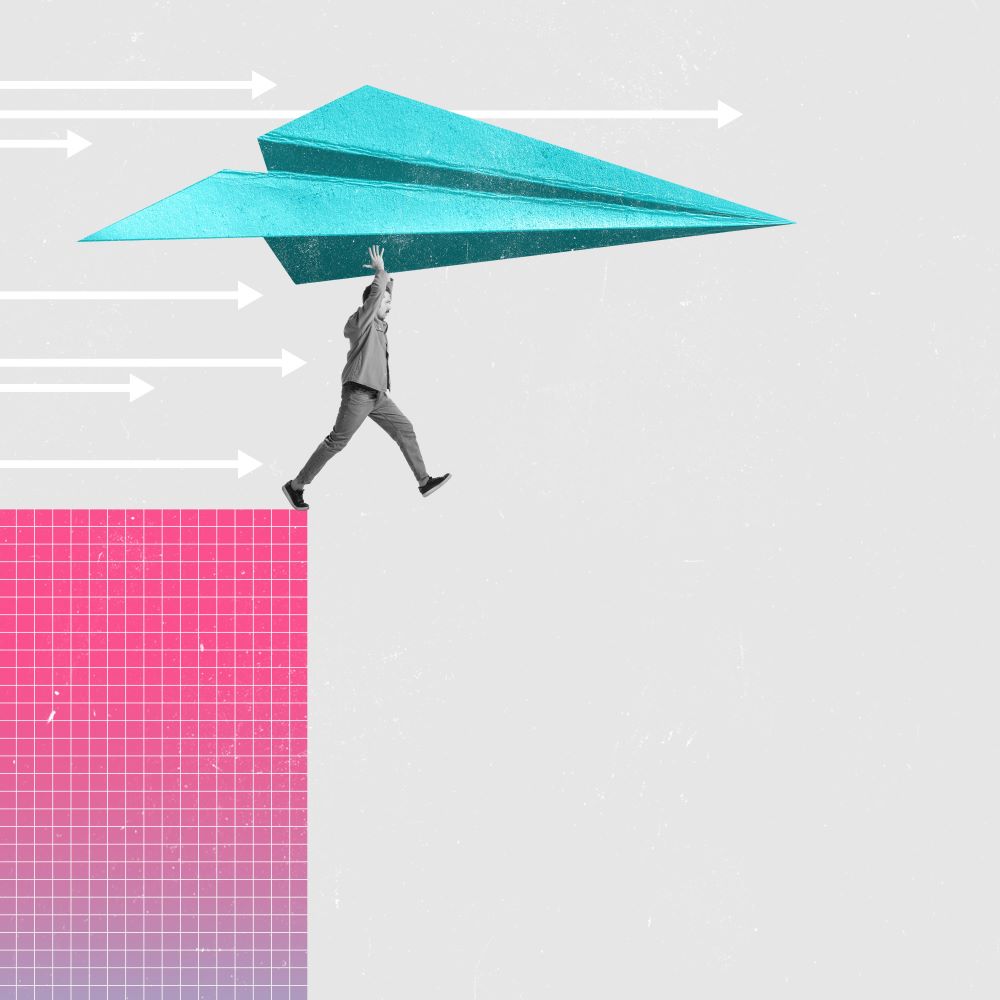By illuminating the inner workings of your brain’s cue-desire-outcome loop, the mechanism that guides your habit formation and generates motivation, we’ll show you how to create a feedback loop that keeps your motivation engine running at full throttle, no matter what challenges lie ahead.
The cue-desire-outcome loop
In your brain, working behind the scenes, a mechanism guides your habit formation and generates motivation: your cue-desire-outcome loop. Here’s how it operates:
- Cue or trigger. This is your trigger, a signal that urges, “It’s time to act!” Picture this: you have a major presentation next week, and as you stroll past your colleague’s desk, you notice they’re already crafting their slides. That sight alone triggers something in your brain – a subtle nudge, a spark of motivation. It’s like a silent call to action. That’s your cue – a vivid reminder of your impending presentation.
- Desire or craving. Once your brain recognizes the cue, it anticipates the potential for a reward and releases a burst of dopamine to ignite your desire to take action. As you walk back to your desk, you envision receiving recognition and praise from your boss after delivering a successful presentation.
- Action or habit. To satisfy your craving for accolades and a sense of accomplishment, you begin you preparing your slides and rehearsing your key points. This is the action associated with the cue.
- Outcome or reward. Your actions, sparked by the cue and driven by desire, generate the outcome. It can swing either positive or negative. If the results meet or surpass your expectations, it reinforces the habit or behavior. Imagine delivering your presentation flawlessly, earning praise from your boss, impressing your colleagues, and basking in the warm glow of pride. Your brain celebrates with another burst of dopamine, cementing the correlation between being well-prepared and earning a satisfying reward.
The loop continues
As you follow this habit loop in response to cues like reminder emails or approaching presentation deadlines, the habit of proactively preparing for presentations becomes more engrained. Your brain associates the cue (deadline, reminder email) with the desire for recognition and success, which drives the action (working on slides) and leads to the reward (sense of accomplishment, praise, potential for career advancement). Over time, this habit loop makes you more proactive in preparing for presentations.

This is how the cue-desire-outcome loop molds our habits. When your behavior consistently delivers positive outcomes, it becomes a habit – something you do almost automatically.
So, how does your brain decide if the outcome of the cue-desire-outcome loop warrants a surge of dopamine to solidify the behavior into a habit? That’s where the brain’s scorekeeper, reward prediction error, comes in.
The brain’s scorekeeper: reward prediction error
Your brain constantly observes cues and calculates which signals lead to rewards and which are mere distractions. This learning forms the cornerstone of your decision-making.
Cues are signals
Cues are signals or triggers in your environment that your brain uses to predict whether you’re on track to achieve your goal
In our presentation scenario, the reward prediction error is your brain’s meticulous scorekeeper. It measures the gap between your anticipated reward and the actual outcome. It’s like your brain’s audit that ensures your effort matches the reward. Here’s how it works:
- Expectation: Before diving into your work presentation, you’re brimming with expectations. You anticipate making progress, feeling accomplished, and taking strides toward being well-prepared. Each expectation forecasts feelings of satisfaction, a sort-of ‘sneak preview’ of the reward waiting for you at the end of your efforts.
- Action: You plunge headfirst into your presentation, investing time and effort in crafting content, visuals, and rehearsing. Every slide completed represents a mini-accomplishment, a visual testament to your progress. Your brain recognizes you’re closing in on your goal and fires off dopamine to spur you across the finish line.
- Outcome: As you toil away, progress materializes, and a sense of accomplishment washes over you. However, the path to victory isn’t straight. You also grapple with challenges – phone notifications that threaten your focus, distractions that hijack your thoughts, and frustrating technical hiccups that throw wrenches in your workflow. When you confront these negative cues or obstacles, your brain experiences a dopamine dip. It’s like your brain recalculating the effort-to-reward equation.
Reward prediction error
It’s the gap between your expectations (recognition, personal satisfaction) and what you got (some progress interlaced with challenges). A positive error reinforces motivation; a negative one can sap it.
In essence, reward prediction error guides your choices to maximize favorable outcomes.
Building an Unstoppable Feedback Loop for Enduring Motivation
Now that we’ve demystified how your brain forms habits with the cue-desire-outcome loop and calculates effort vs. reward using reward prediction error, it’s time to unfold your roadmap to maintaining motivation like a pro:
- Understand the Cue-Desire-Outcome Loop: Recognize that your brain operates in this loop, driven by dopamine – your motivation fuel.
- Harness Small Wins: Break down your lofty goals into bite-sized tasks, writing down each. As you complete each step, cross it off your list as a visual indication of your progress. This act creates a sense of accomplishment and fortifies your motivation to continue.
- Craft Clear Cues: Establish cues that signal the beginning of a task or goal. For example, a ritual of savoring coffee as you plan your day or priming yourself for work with a brief warm-up or stretch before physically demanding tasks. These actions or cues mark the transition into work and initiate the desire phase of the cue-desire-outcome loop.
- Celebrate Progress: As milestones pass on your path to progress, take a moment to celebrate these feats. Offer yourself a verbal pat on the back, savor a coffee break, take a leisurely stroll, or treat yourself to a favorite snack. This celebration triggers dopamine release, fueling your motivation to forge ahead.
- Visualize Success: Paint a vivid mental picture of the final successful outcome. Visualizing the positive outcome triggers dopamine release and supercharges your motivation to strive for that glorious victory.
- Mindfully Manage Pain Points: Acknowledge that the desire phase is about anticipating the reward and grappling with the discomfort of its absence. Embrace the discomfort as a motivator, knowing that achieving your goal will bring a reward.
- Engage in Self-Reflection: Regularly reflect on your progress and the cues that lead to your desired outcomes. Adjust your approach as needed based on your experiences.
By applying these principles, you’re not merely working; you’re collaborating with your brain’s reward system to amplify motivation, conquer procrastination, and make steady progress. The secret is cultivating a positive feedback loop where each step reinforces your motivation, keeping you on course.

